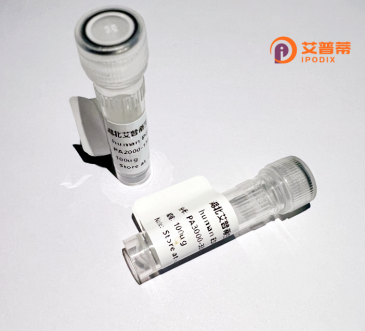
| 纯度 | >90%SDS-PAGE. |
| 种属 | Human |
| 靶点 | TIAM2 |
| Uniprot No | Q8IVF5 |
| 内毒素 | < 0.01EU/μg |
| 表达宿主 | E.coli |
| 表达区间 | 1-626 aa |
| 活性数据 | MEGPRENQDPPPRPLARHLSDADRLRKVIQELVDTEKSYVKDLSCLFELYLEPLQNETFLTQDEMESLFGSLPEMLEFQKVFLETLEDGISASSDFNTLETPSQFRKLLFSLGGSFLYYADHFKLYSGFCANHIKVQKVLERAKTDKAFKAFLDARNPTKQHSSTLESYLIKPVQRVLKYPLLLKELVSLTDQESEEHYHLTEALKAMEKVASHINEMQKIYEDYGTVFDQLVAEQSGTEKEVTELSMGELLMHSTVSWLNPFLSLGKARKDLELTVFVFKRAVILVYKENCKLKKKLPSNSRPAHNSTDLDPFKFRWLIPISALQVRLGNPAGTENNSIWELIHTKSEIEGRPETIFQLCCSDSESKTNIVKVIRSILRENFRRHIKCELPLEKTCKDRLVPLKNRVPVSAKLASSRSLKVLKNSSSNEWTGETGKGTLLDSDEGSLSSGTQSSGCPTAEGRQDSKSTSPGKYPHPGLADFADNLIKESDILSDEDDDHRQTVKQGSPTKDIEIQFQRLRISEDPDVHPEAEQQPGPESGEGQKGGEQPKLVRGHFCPIKRKANSTKRDRGTLLKAQIRHQSLDSQSENATIDLNSVLEREFSVQSLTSVVSEECFYETESHGKS |
| 分子量 | 97.2 kDa |
| 蛋白标签 | GST-tag at N-terminal |
| 缓冲液 | PBS, pH7.4, containing 0.01% SKL, 1mM DTT, 5% Trehalose and Proclin300. |
| 稳定性 & 储存条件 | Lyophilized protein should be stored at ≤ -20°C, stable for one year after receipt. Reconstituted protein solution can be stored at 2-8°C for 2-7 days. Aliquots of reconstituted samples are stable at ≤ -20°C for 3 months. |
| 复溶 | Always centrifuge tubes before opening.Do not mix by vortex or pipetting. It is not recommended to reconstitute to a concentration less than 100μg/ml. Dissolve the lyophilized protein in distilled water. Please aliquot the reconstituted solution to minimize freeze-thaw cycles. |
以下是关于重组人TIAM2蛋白的3篇模拟参考文献(注:以下内容为假设性示例,如需真实文献建议通过学术数据库检索):
---
1. **文献名称**:*"TIAM2 promotes lung cancer metastasis via Wnt/β-catenin pathway activation"*
**作者**:Xie, L., et al. (2018)
**摘要**:研究报道了重组人TIAM2蛋白在肺癌细胞中的过表达通过激活Wnt/β-catenin信号通路,增强肿瘤细胞的迁移和侵袭能力,揭示了其在癌症转移中的关键作用。
2. **文献名称**:*"Role of TIAM2-Rac1 signaling in colorectal cancer progression"*
**作者**:Li, Y., et al. (2016)
**摘要**:通过体外实验发现,重组TIAM2蛋白通过激活Rac1 GTP酶调控细胞骨架重塑,进而促进结直肠癌细胞的侵袭和转移,提示其作为潜在治疗靶点。
3. **文献名称**:*"Structural and functional analysis of recombinant human TIAM2 protein"*
**作者**:Wang, H., et al. (2019)
**摘要**:首次成功表达并纯化重组人TIAM2蛋白,解析其结构域特征,证明其与细胞膜脂质结合的能力及对下游信号通路的调控机制。
---
如需具体文献,建议通过PubMed或Google Scholar以关键词 **"TIAM2 recombinant protein"** 或 **"TIAM2 signaling"** 检索近期研究。
**Background of Recombinant Human TIAM2 Protein**
TIAM2 (T-cell lymphoma invasion and metastasis-inducing protein 2) is a member of the guanine nucleotide exchange factor (GEF) family that activates Rho GTPases, particularly Rac1. by facilitating the exchange of GDP for GTP. It plays a critical role in regulating cytoskeletal dynamics, cell migration, and intracellular signaling pathways linked to cancer progression, neuronal development, and epithelial-mesenchymal transition (EMT). The protein contains conserved structural domains, including a DH (Dbl-homology) domain responsible for GEF activity and a PH (pleckstrin homology) domain for membrane localization.
Recombinant human TIAM2 protein is produced using biotechnological systems (e.g., *E. coli*, insect, or mammalian cells*) to ensure proper folding and post-translational modifications. Its production enables detailed biochemical and functional studies, such as analyzing Rac1 activation kinetics, protein-protein interactions, or screening therapeutic inhibitors. In cancer research, TIAM2 is implicated in promoting tumor invasiveness and metastasis, making it a potential biomarker or therapeutic target. However, its context-dependent roles—acting as both an oncogene and tumor suppressor in certain settings—highlight the complexity of its regulatory mechanisms. Current studies focus on understanding its interplay with signaling networks (e.g., Wnt, PI3K) and its role in neurological disorders. Recombinant TIAM2 serves as a vital tool to dissect these pathways and advance targeted drug discovery.
×